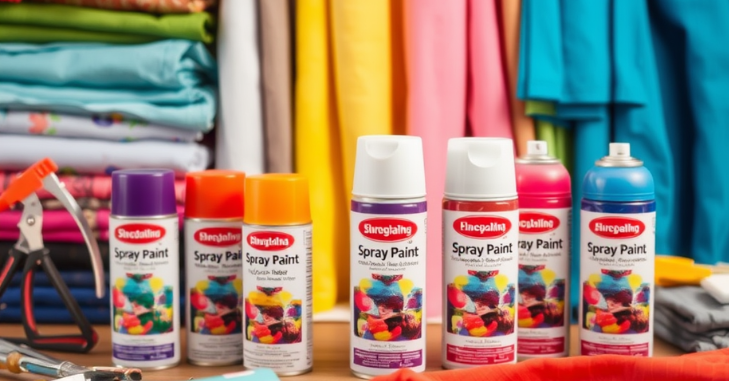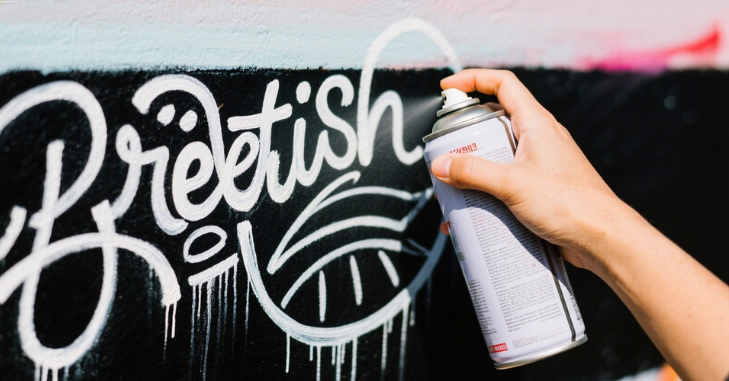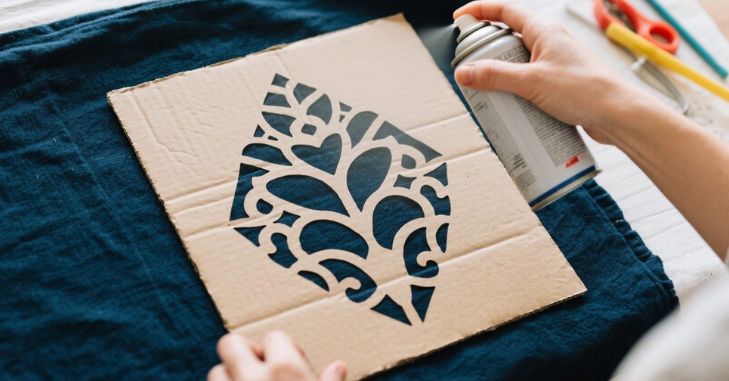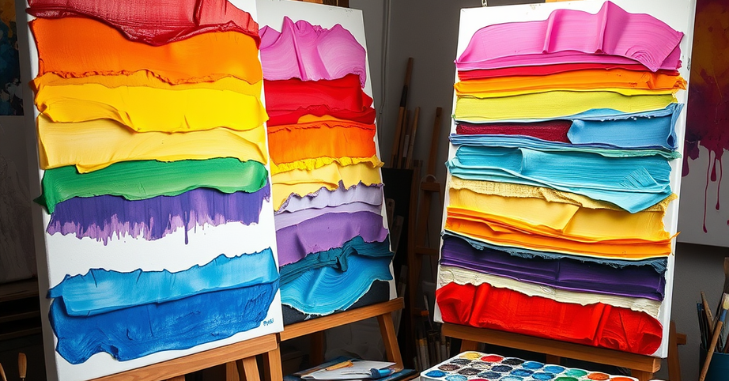Last Updated on June 4, 2025 by Muhammad Binyameen
Table of Contents
Introduction
Spray paint for fabric has revolutionized how artists, designers, and DIY enthusiasts approach textile customization. Whether you want to revamp an old jacket, create unique patterns on curtains, or add a splash of color to your sneakers, spray paint designed specifically for fabric offers an easy and effective solution.
This guide will cover everything you need to know about spray paint for fabric, from choosing the right type, preparing your textiles, and mastering application techniques to ensuring durability and washability.
By the end, you’ll be equipped to transform ordinary fabrics into extraordinary works of art with color, creativity, and lasting quality.
| Brand/Type | Finish | Best For | Dry Time | Washable? | Unique Features |
| Tulip ColorShot | Matte | Cotton, canvas | 30 minutes | Yes | Wide color range, soft finish |
| Simply Spray Soft Fabric | Soft, flexible | T-shirts, upholstery | 1 hour | Yes | Non-toxic, odorless, safe for kids |
| Krylon Fabric Spray Paint | Satin | Denim, curtains, cushions | 1 hour | Spot clean | Durable and fade-resistant |
| Dupli-Color Vinyl & Fabric | Glossy | Car seats, vinyl surfaces | 30 minutes | No | Restores color on automotive fabrics |
| Design Master TintIt | Translucent tint | Light decorative fabrics | 15–30 minutes | No | Subtle tinting for soft hues and gradients |
| Marabu Fashion Spray | Vibrant matte | Mixed media, art clothing | 15–20 minutes | Yes | Can be heat-set for permanency |
Understanding Spray Paint for Fabric: What Makes It Unique?
Spray paint for fabric differs significantly from traditional spray paints used on wood, metal, or plastic. The key lies in its formulation, which is designed to adhere flexibly to textile fibers without cracking or peeling. Unlike regular spray paint, fabric spray paint contains binders that allow the paint to move with the fabric, preserving softness and breathability.
Using the right spray paint for fabric ensures that your projects maintain their vibrant colors and texture, even after multiple washes. Moreover, these paints are often water-based or have low VOCs (volatile organic compounds), making them environmentally friendlier for indoor use.

How to Choose the Best Spray Paint for Fabric
Selecting the appropriate spray paint is crucial for achieving professional-looking results. Several factors should influence your choice:
- Type of Fabric: Natural fibers like cotton and linen absorb paint differently than synthetic fibers such as polyester or nylon. Some spray paints are formulated specifically for specific fabric types.
- Color Vibrancy and Finish: Consider whether you want a matte, glossy, or metallic finish. Some spray paints offer various colors and finishes to suit your creative vision.
- Durability and Washability: Check if the paint is labeled as washable or permanent. High-quality fabric spray paints withstand repeated laundering without fading or cracking.
- Application Method: Some paints come with adjustable nozzles for fine or broad spray patterns, allowing more control over your design.
- Safety and Environmental Impact: Opt for non-toxic, low-odor paints, especially if working indoors or with children.
Preparing Your Fabric for Spray Painting
Preparation is key to a successful fabric spray paint project. Wash the fabric to remove dirt, oils, or sizing that could prevent paint adhesion. Avoid fabric softeners, as they can interfere with the paint’s ability to bind.
Lay the fabric flat on a protected surface, such as a drop cloth or cardboard, to prevent overspray damage. Use painter’s tape or stencils to mask off areas you want to keep paint-free or create intricate patterns.
Turning garments inside out and securing them on a flat surface helps achieve even coverage. Always work in a well-ventilated area or outdoors to avoid inhaling fumes.

Step-by-Step Guide to Applying Spray Paint on Fabric
- Shake the Can Thoroughly: Before spraying, shake the paint can for at least one minute to mix the pigments and binder evenly.
- Test Spray: Always test the spray on a scrap piece of fabric to check color, spray pattern, and drying time.
- Maintain Proper Distance: Hold the spray can about 8 to 12 inches from the fabric to avoid drips and achieve an even coat.
- Apply Light Coats: Spray in light, even layers, allowing each coat to dry before applying the next. This prevents paint buildup and stiffness.
- Use Masking for Patterns: When creating designs, use stencils or tape to block off sections. Remove the masking carefully after the paint dries.
- Dry and Cure: Let the painted fabric dry completely for 24 hours. Some paints recommend heat-setting with an iron or dryer to improve durability.
Ensuring Durability and Washability of Spray-Painted Fabrics
Durability is a common concern when working with spray paint on fabric. To maximize longevity, follow the manufacturer’s instructions for curing and heat-setting. Many fabric spray paints require ironing on the reverse side or placing the fabric in a dryer to fix the paint.
Washing painted fabrics should be done gently. Use cold water and mild detergents, and avoid bleach or harsh chemicals. Air drying is preferable to maintain the paint’s integrity. Over time, even the best paints may show slight fading, but proper care can extend the life of your customized textiles.
Techniques for Applying Spray Paint on Fabric
There are various techniques you can employ when using spray paint on fabric:
1. Freehand Painting
Use the spray can to create your designs freehand. This method allows for spontaneity and creativity.

2. Stenciling
Create stencils by cutting out shapes or patterns from cardboard or plastic. Hold the stencil against the fabric and spray over it for crisp designs.

3. Ombré Effects
To achieve a gradient effect, spray a lighter shade at the top and gradually blend in a darker shade towards the bottom.
4. Layering Colors
Apply multiple layers of different colors to create depth and complexity in your design. Allow each layer to dry before adding the next.

| Brand | Finish Options | Drying Time | Washability | Price Range (USD) | Special Features |
| Tulip ColorShot | Matte, Metallic | 10-15 mins | Machine washable | $8 – $12 | Vibrant colors, easy application |
| Simply Spray Fabric | Matte | 15 mins | Hand wash recommended | $10 – $15 | Low-odor, eco-friendly |
| Design Master | Matte, Satin, Gloss | 5-10 mins | Machine washable | $12 – $18 | Wide color range, adjustable nozzle |
| Montana Gold | Matte | 10-15 mins | Machine washable | $15 – $20 | High pigment, professional grade |
| Krylon Fabric | Matte | 10 mins | Machine washable | $7 – $10 | Affordable, good coverage |
Troubleshooting Common Issues with Fabric Spray Paint
Sometimes, spray painting fabric doesn’t go as planned. If you notice paint bleeding under stencils, use painter’s tape with a stronger adhesive or a light coat of adhesive spray to hold the stencil firmly.
If the paint feels stiff after drying, applying a fabric softener during washing can help restore flexibility. Uneven color can be corrected by applying additional light coats, allowing each to dry thoroughly.
For paint that flakes or cracks, ensure proper curing and avoid overloading the fabric with paint. Always follow the recommended drying and heat-setting procedures.
Spray Paint for Fabric vs. Traditional Paints and Dyes
While traditional paints require brushes and can become stiff or crack, spray paint offers an even coat with minimal texture changes. Dyes penetrate deeply but are time-intensive and limit precision. Spray paint balances speed, control, and a broad palette, making it ideal for novices and experienced crafters.
Maintenance and Washability
Once you’ve transformed your textiles, you want the results to last. Most fabric spray paints are machine-washable or hand-washable after a curing period (typically 72 hours). Always check the label. Turn items inside out before washing, use gentle detergents, and avoid bleach or high heat.
Conclusion
Spray paint for fabric is a fantastic tool for anyone looking to transform textiles with color, creativity, and durability. By understanding the unique properties of fabric spray paints, preparing your materials properly, and applying paint with care, you can create stunning, long-lasting designs on various fabrics.
Whether refreshing old clothes, customizing home decor, or embarking on an artistic project, fabric spray paint offers endless possibilities to express your style and imagination.
Apart from that if you want to know about “White Sneakers to Wear with Dresses: Pairing Tips” then please visit our “Fashion” Category.
FAQs
Some fabric spray paints require heat-setting (using an iron or dryer) to lock in color. Always check the manufacturer’s instructions for best results.
Natural fabrics like cotton, linen, and canvas absorb spray paint well. Synthetic fabrics can work too, but results may vary, and testing on a small patch is recommended.
Most fabric spray paints are designed to be permanent after drying and curing. For extra durability, especially for washable and heat-set options, look for washable and heat-set optionsons, look for items that will be washed.
No, regular spray paint is not designed for fabrics and can make textiles stiff, crack, or peel. Always use spray paint formulated explicitly for fabrics to ensure flexibility and durability.






















